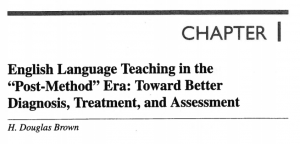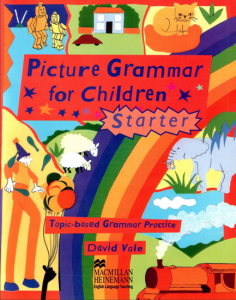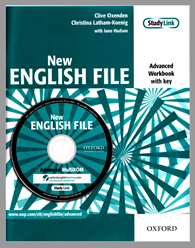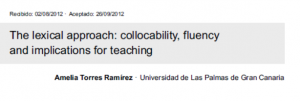According to Howatt, in the sixteenth century, English was the main language of England, French was a prominent deed, and while Latin lingered as the symbol of an enlightened person, its grammar was the only one taught in school. It was not until the seventeenth century that a scholarly description of the English language was produced. In the lack of a syntactical account of the language, old language teaching materials, predominantly dependent on texts and dialogues, were transformed for the teaching of English. Dialogues were a deep-rooted convention in Latin teaching, in addition to question-and-answer techniques. These techniques came from a previous teaching design, regular in orate groups, where the objective was to learn literally written texts by heart (Howatt, 1984, pp. 3-6). Joseph Priestley’s The Rudiments of English Grammar written in 1761 is a late but conventional model where it shows how the Classical Method made students put tremendous effort into memorization while the teacher only had to sit down and purely ask them the questions. A good example from the book on page 13 illustrates this. The teacher would ask “What is a verb?” and the students would answer “A Verb is a word that expresseth what is affirmed of, or attributed to a thing; as I love; the horse neighs” (Priestley, 1772, p. 13). The teacher would again question the students “How many kinds of verbs are there?” and once again the students would answer “Two; Transitive and Neuter” (Priestley, 1772, p. 13). At the end of the sixteenth century, the first ESL textbooks appeared, thanks to French refugees (Howatt, 1984, p. 6).
Howatt suggests that an appeal in learning the language appeared among people of the trade section. Double-manuals seeking to teach English to French people and French to English people start flourishing. William Caxton, a member of the trade community in Bruges, organized and printed in 1483 a double-manual. His manual endorses the previous manuals, though it is bilingual and direct, not containing any linguistic information about either language. It has household tools, shopping lists (with typical stuff you find on a market), a dialogue about selling and buying textiles of various types, words describing family relationships, etc. in summary texts intended toward vocabulary building for students. What is most fascinating about Caxton’s manual is that he brings the L2 next to the L1. The following dialogue is a good example of this (Howatt, 1984, pp. 6-7).
A vostre pere et a vostre mere, To your fadre and to your modre,
A vostre tayon et a vostre taye, To your belfadre & to your beldame,
A vostre onlce et a vostre aunte, To your eme & to your aunte,
A vostre cosyns et a vostre cosynes, To your cosyns and to your nieces
(Caxton, 1483, p. 6)
Caxton is the first one who analyzed that daily language should be taught and that L2 should be given the same status as the L1. He puts the original text and the translation in the same line, which is less useful than what Caxton’s assistant, Wynken de Worde did only 15 years later. He produced a similar double-manual called A Lytell treatyse for to lerne Englysshe and Frensshe (c. 1498). Contrary to his former boss, de Worde set the L2 and the L1 in interchanging lines (Howatt, 1984, pp. 7-8). The presumption is, that it makes a word by word translation much easier.
Here is a good boke to lerne to speke Frenshe
Vecy ung bon livre apprendre parler françoys
In the name of the fader and the sone
En nom du pere et du filz (de Worde, c. 1498, qtd. in Howatt 1984, p. 8)
Signs of a flourishing interest in the English language can be noticed in the form of multilingual dictionaries and phrasebooks that started to incorporate English as one of its main languages. The earliest is a 1540 dictionary, published in Antwerp, called the Alston Bibliography which contains seven languages: Latin, Italian, French, Spanish, Dutch, High-Dutch, and English (Howatt, 1984, p. 8).
Howatt further states that in 1572, French refugees settled in England, and among these refugees were teachers. Three of these teachers made themselves noteworthy, namely Jacques Bellot, Claudius Holyband, and John Florio. Florio and Holyband were native speakers of the L2 they taught but kept teaching the traditional bilingual way. The two small English manuals that Jacques Bellot wrote in the 1580s, The English Schoolmaster (1580) and the second book Familiar Dialogues (1586) reflect an important insight into basic literacy and daily dialogues. In the Schoolmaster, Bellot presents the English alphabet, pronunciation, some grammatical issues, and words that students would have some difficulty with, such as “hole/whole, bore/boar, horse/hoarse or common ambiguities such as right, straight, and hold” (Howatt, 1984, p. 16). Presenting these words and clarifications in print provided insight to the students that had only learned the language in the streets (Howatt, 1984, pp. 12-16). His second book focuses more on a household environment, particularly shopping. He presents a long sequence of shopping scenes that last the course of a single day. After waking up and preparing the kids for school, the characters then drop by common shops, ending the day by having the neighbors over for dinner. The conversation during dinner focuses on recent topics and later the characters play games. What makes it important to ESL teaching is the fact that at in all these events, he incorporated a rough phonetic note of the L2 texts (Howatt, 1984, pp. 16-19).
According to Howatt, Claudius Holyband wrote two major textbooks, The French Schoolmaster (1570) and The French Littleton (1573). The two are also teaching manuals, and both adopt dialogues. The main distinction between these two books and Bellot’s is that it contains instruction on grammar and pronunciation. The Schoolmaster brings this information early and the Littleton in its appendix. They also have a vast vocabulary list. Holyband’s dialogues are presented like Bellot’s daily life situations, where considerable scenes are presented in sequence. These scenes come from many different backgrounds. One for example is school, and according to Howatt, they served their educational purpose quite well. Every scene is comprising of enough material for one lecture while keeping the context from one class to the next. The students read the text out loud, repeating it until they reached a fair pronunciation. Subsequently, the children wrote down the text from the L1 to the L2 and then from the L2 to the L1. Regarding grammar, Holyband consulted grammar rules only after the students had a very good comprehension of the texts. For him, grammar only fits in a more elaborate course (Howatt, 1984, pp. 21-24).
Howatt describes the third of these refugee-teachers, John Florio, as someone who interprets language teaching differently. His two double-manuals, First Fruits (1578) and Second Fruits (1591) include dialogues in Italian and English. They contain, as the two authors before, something that later would come to be considered very important to future methods: situational themes. Situations such as getting accommodation and being in contact with a landlord are examples of that. As an intense student of language, Florio gathered lexicographical works and many proverbs in his books. The interesting takes from Florio’s works are the situational themes, the use of proverbs, and golden sayings. These aspects later, by the use of chunks, became essential to future methods (Howatt, 1984, pp. 25-27).
Howatt continues his analysis, and at the beginning of the seventeenth century, a tradesman from France called George Mason composed a handbook with the name Grammaire Angloise (1622). In it, he presented rough phonetic transcription of the conversations. What makes this important is that he gives notability to the verb form, progressive or continuous. This shows how the teaching and analysis of English grammar were growing apart from its Latin route (Howatt, 1984, pp. 29-30).
According to Howatt, a clear change in classrooms happened during the seventeenth century, a period where most young children attended grammar school to obtain elementary instruction on their L1. These students were immediately conditioned by Latin grammar books with no alternative but to memorize its rules and definitions, and if that did not occur, they risked physical repercussions. So, in such circumstances, many new and different ideas started to emerge during this period. The only thing that brought these new ideas together was the preference of text rather than rules. A good example is Roger Ascham’s book The Schoolmaster (1570) (Howatt, 1984, pp. 32-33). Howatt describes Ascham’s Schoolmaster as a book directed exclusively to the education of a specific child, and that it is divided into two parts. The first part is named The Bringing Up of Children where he discusses the education, the reasons, and the goals of a noble child. He believed that by presenting the child with the ancient literature, it would eventually spark understanding and culture upon that child. In The Ready Way to the Latin Tongue (the second part of his book), he explains how to achieve the educational goals of the first part, within a pedagogical curriculum. The “double-translation” is the most popular procedure, where Ascham gives L1 and L2 the same status, helping the student understand the structure of the L1 and the L2, by presenting the L2’s literature (Howatt, 1984, pp. 33-34).
According to Howatt, Joseph Webbe designed a language textbook called An Appeal to Truth (1622), in which he removed grammar altogether. He believed that grammar rules were inadequate in their portrayal of language and that by studying them, the students would lose valuable time. He then focused on exercising communication skills, believing that these skills would eventually lead to an understanding of grammar. He also believed that translation was important in L2 vocabulary building, but he did not agree with L2 word-by-word translation to L1, holding the belief that translation equivalence existed only at the level of the construction. He conditioned his method to this perception. Howatt brings Webbe in the same line, with the conditions of the later known Direct Method (Howatt, 1984, pp. 35-37).
As attested by Howatt, Jan Amos Comenius wrote two books, the Janua Linguarum Reserata (1631) and the Orbis Sensualium Pictus, published in Nuremberg in 1658. He saw education in an extremely specific way and used the metaphor of the Temple for his educational stages. The first stage was Vestibulum, the second Janua, the third Palatium, and the fourth Thesaurus. He visualized two textbooks, each with four stages (according to the temple stages).
The first important observation regarding Comenius’ work towards a better language teaching method is that in the Vestibulum, which only had a few hundred words designed for simple daily conversations, he added a list of additional words, acknowledging which words to focus on. In the Janua he increased that emphasis by essentially creating a school textbook central to the teaching of 8,000 words in a sequence of graded texts with a small dictionary being attached. The Palatium, which never came to light, was supposed to introduce the accurate use of language and style. Lastly, the Thesaurus, which also never came to light, would have been largely dedicated to the contrasting characteristics of the L1 and L2, and of course, translation.
Comenius did not make great progress with his method, but he did come up with insights. In the Vestibulum he arranged Latin texts side-by-side to other languages in text. Another great insight of Comenius is that he started the section The Accidents of Things that focuses on teaching basic nouns by employing short constructions such as “The grass is green, The chimney is full of smoke” (Howatt, 1984, p. 42) and so on. The section called Things Concerning Actions and Passions focuses on verbs in the simple present tense. Circumstantial Things focuses on prepositional phrases and adverbs.
And the final chapters address vocabulary building. He captured all the words he used in the texts and placed them in the Index Verborum. The Solid Things part is where he ordered in different topic categories, one hundred texts. The texts were short so the teachers could address them slowly in class and as a teacher Comenius knew that having the children around him, an early teacher-centric view of the classroom, made it easy for him to handle the class. He started every class focusing on the short text and only went on when he was certain that the students had grasped the content of the text (Howatt, 1984, pp. 40-44). Howatt continues his description of Comenius and his second book, the Orbis Sensualium Pictus.
Here, Comenius makes usage of another great process in language teaching. He started each Orbis lesson with a picture which was linked to the words in the text. This shows that providing more input for the creation of a memory helped the students remember the words easier. In his view the teacher should start each class addressing the picture, and, when available, the teacher should provide the real object to the students. Not satisfied with it, he went a bit further and suggested that the students could draw or color the objects themselves. He also believed that the students could disclose their personal lives, feelings, and ideas in the classroom. Most of Comenius’ suggestions were picked up for my preferred teaching approach (Howatt, 1984, p. 46).
In the second half of the seventeenth century, according to Howatt, a requirement for French native-speaking teachers arose in Britain. These French speaking teachers not only did their jobs, but they also focused on teaching ESL to the French-speaking refugees who were living in Britain at the time. There was a Swiss man among these French teachers named Guy Miège whose Nouvelle Méthode pour apprendre l’Anglois (1685) elevated the teaching of English as a foreign language to a professional standard. His Nouvelle Méthode was published by him and translated into English as a non-native speaker named The English Grammar (1688).
The original book has 270 pages addressing grammar and dialogues and even incorporating a small dictionary. In the 119 pages addressed to grammar, he specifically focused on orthography and the pronunciation of English, as well as words forms and base paradigms. He believed that once the student had learned the fundamentals of spelling and sound systems of English, they would have a much easier time. Teaching the principles of pronunciation, grammar and spelling were fundamental to Miège as well as the teaching of phrases and dialogues. Some of these ideas were well incorporated into my preferred teaching approach. He also supported the idea of columns and braces to help understand visually and condemned the idea of learning a language leaving the grammar rules out in the beginning. Despite that, he allowed his students who were unwilling to learn grammar first, to memorize the texts before addressing the rules (Howatt, 1984, pp. 53-57).










